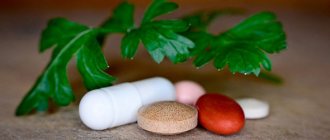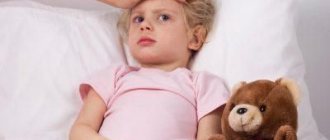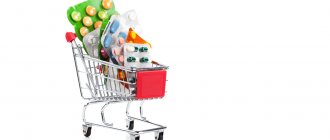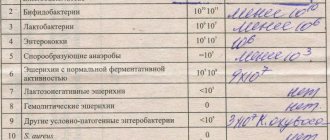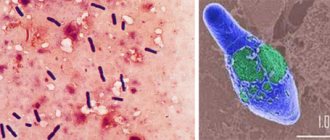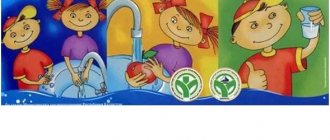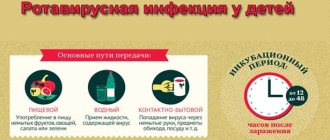Intestinal infection is the most common disease. The largest number of people suffering from this infection live in the hottest countries of our planet. However, this does not mean that the population of our country has not encountered it.
Intestinal infections are especially active in the summer and autumn. However, during the rest of the year, outbreaks of this infection are also recorded, albeit in smaller numbers. Conventionally, pathogens of E. coli are divided into 3 groups:
- Viruses. This group includes rotaviruses, adenoviruses, and noroviruses.
- Bacteria. These include salmonella, shigella, dysentery bacillus, proteus, and E. coli.
- The simplest pathogens. They are considered amoeba and balantidium.
The most vulnerable category of the population to E. coli is children. They are very difficult to treat. After all, in order to eliminate the symptoms of the disease, you must take all medications prescribed by your doctor and follow a therapeutic diet. In this article we will look at how to feed a child during a therapeutic diet?
Principles of dietary nutrition
The therapeutic diet should be varied.
When composing a therapeutic diet, you must remember that food should be easily digestible and varied in taste.
This is especially important for children. It is quite difficult to persuade a sick child to eat, and if you constantly give the same food, he will become bored and tasteless.
Nutrition for intestinal infections in children should be based on the following principles:
- Dietary nutrition must be followed during the illness and for 14 days after it. The fact is that it takes time to restore the intestinal mucosa. Final recovery after an infection attack occurs only 14 days after recovery.
- With frequent vomiting, food causes new attacks. To allow the child to eat, it is necessary to eliminate the attacks of vomiting. In order not to provoke the appearance of diarrhea, the child should be given food often, but in small portions.
- If the disease becomes more complicated, you will need to reduce your daily food intake by 50%. However, don't make the mistake of cutting out food entirely. This is because the digestive process does not stop, even if there is very severe inflammation. But the body needs nutrients to fight intestinal infections.
- Steaming is recommended; boiled food is also allowed. The child's diet should contain foods that contain the required amount of proteins. It is imperative to exclude from the child’s menu foods that stimulate intestinal motility and the functioning of the digestive glands.
- Eliminate foods that cause fermentation and increased gas formation from the diet.
- Under no circumstances should you give your baby whole milk for 2 weeks. This is due to the fact that even after eliminating the inflammatory process in the intestines, the activity of enzymes in the intestinal mucosa decreases.
- Do not ignore these recommendations, because... the fermentation process may lead to lactase deficiency in the future.
- Introduce fermented milk products into your child's diet. The fact is that lactic acid and lactobacilli, which are contained in fermented milk products, have a toxic effect on pathogenic microflora. In addition, fermented milk products are enriched with vitamins B and C, which promote the construction of new intestinal epithelial cells.
After rotavirus: how to help a child?
The article was prepared by pediatrician Nina Aleksandrovna Belich
Most parents, unfortunately, are familiar with such an unpleasant phenomenon as “rotavirus” firsthand. And if there are no more problems with treatment, then the recovery period sometimes raises questions. How to properly care for a child so that he recovers as quickly as possible?
The most important thing is to act gradually. Even if it seems to you that your child is completely healthy and behaves as usual, you should not rush to conclusions. The body affected by rotavirus waged an active fight and is just beginning to regain strength.
Regulate your drinking regime
Drinking plenty of fluids is one of the most important factors in successfully fighting any simple virus. With rotavirus, of course, everything is even more prosaic - during the period of illness, your child has lost a lot of fluid, but has not yet had time to restore the water balance. Little by little, reintroduce the drinks he enjoyed before the strict diet (you can start with a few sips so as not to overload the stomach), but maintain the amount of clean water.
Provide complete peace
For proper and healthy digestion, as well as for a speedy recovery, you need good sleep. Give your child the opportunity to sleep as much as his body requires. If this means going for a walk a little later or missing one day of school, well, health is more important. By the way, the bedroom should be ventilated no less frequently than during illness, in order to exclude the possibility of re-infection.
Limit contact with other people
Walking and playing is very beneficial, but not when the immune system is already weakened. Try to avoid large crowds of people, do not let your child dig in the sand or touch too many surfaces, and if possible, carry antibacterial gel with you. It is also better to keep them away from relatives for a short time.
Gradually “come out” of the diet
It is better to introduce citrus fruits, dairy, sweet and meat products last - they are the ones that can irritate the child’s intestines the most. Start with a small amount of fruit, something slightly salty or spicy. And, most importantly, act gradually. Even if your child is already running, jumping and wants to eat everything, do not rely on external signs.
And, of course, be sure to consult a pediatrician - an experienced specialist will be able to give personalized advice and create a “program” for a speedy recovery.
MAKE AN APPOINTMENT WITH A PEDIATOR
What can a child eat during a therapeutic diet?
Buckwheat porridge must be cooked in water.
If you have frequent vomiting and diarrhea, you can feed your child with water-based porridge. You can give the following porridges cooked in water:
- Corn
- Rice
- Buckwheat
It is preferable to start with rice porridge, because... Rice helps normalize stool.
When the stool is normalized, you can try eating porridge from other cereals. It is not advisable to feed your child millet porridge, oatmeal or pearl barley. This is necessary in order to avoid the formation of a fermentation process in the intestines.
The inclusion of lean meat in the diet (chicken breast, turkey, rabbit, veal) is encouraged. The meat should be steamed, but it can also be boiled. Before serving food, the meat must be ground in a blender. You can also make steamed cutlets from lean meat. However, keep in mind that you can give meat only after porridge (that is, when the child’s stool returns to normal).
For children over 1 year old, it is permissible to use canned meat for baby food. After some time, you can try introducing fermented milk products (yogurt, kefir, cottage cheese) into your diet. Please note that you need to be very careful when introducing fermented milk products.
You need to start with 1 spoon, doubling the dose daily. If you see that your baby’s health is stable and the consistency of the stool has not changed, then the consumption of fermented milk products can be increased to the dose that corresponds to the age norm.
Do not rush to introduce vegetables and fruits into your diet. Save this for last. When it's time to introduce them, steam or bake them first. Roughly speaking, you can serve your child only food that has been heat-treated. Let your child eat all his food pureed. Introduce vegetables into the diet in the following order:
Intestinal infection in children
Dysentery in children
After a short incubation period (1-7 days), the temperature rises sharply (up to 39-40° C), weakness and fatigue increase, appetite decreases, and vomiting is possible.
Against the background of fever, there is a headache, chills, and sometimes delirium, convulsions, and loss of consciousness. Intestinal infection in children is accompanied by cramping abdominal pain localized in the left iliac region, symptoms of distal colitis (pain and spasm of the sigmoid colon, tenesmus with rectal prolapse), symptoms of sphincteritis. The frequency of bowel movements can vary from 4-6 to 15-20 times per day. With dysentery, the stool is liquid, containing impurities of cloudy mucus and blood. In severe forms of dysentery, hemorrhagic syndrome may develop, including intestinal bleeding. In young children with intestinal infection, general intoxication prevails over colitis syndrome; disturbances in hemodynamics, electrolyte and protein metabolism occur more often. The most common intestinal infection in children is caused by Shigella Zona; heavier - Shigella Flexner and Grigoriez-Shig.
Salmonellosis in children
Most often (in 90% of cases) the gastrointestinal form of salmonellosis develops, occurring as gastritis, gastroenteritis, gastroenterocolitis. Characterized by subacute onset, febrile fever, adynamia, vomiting, hepatosplenomegaly. Stool with salmonellosis is liquid, copious, fecal, the color of “swamp mud”, with admixtures of mucus and blood. Typically, this form of intestinal infection ends in recovery, but in infants it can be fatal due to severe intestinal toxicosis.
Influenza-like (respiratory) form of intestinal infection occurs in 4-5% of children. In this form, Salmonella is detected in cultured material from the throat. Its course is characterized by febrile temperature, headache, arthralgia and myalgia, symptoms of rhinitis, pharyngitis, conjunctivitis. From the cardiovascular system, tachycardia and arterial hypotension are noted.
The typhus-like form of salmonellosis in children accounts for 2% of clinical cases. It occurs with a long period of fever (up to 3-4 weeks), severe intoxication, and dysfunction of the cardiovascular system (tachycardia, bradycardia).
The septic form of intestinal infection usually develops in children in the first months of life who have an unfavorable premorbid background. It accounts for about 2-3% of cases of salmonellosis in children. The disease is extremely severe, accompanied by septicemia or septicopyemia, disruption of all types of metabolism, and the development of severe complications (pneumonia, parenchymal hepatitis, otoanthritis, meningitis, osteomyelitis).
Escherichiosis in children
This group of intestinal infections in children is extremely extensive and includes coli infections caused by enteropathogenic, enterotoxigenic, enteroinvasive, and enterohemorrhagic Escherichia.
Intestinal infection in children caused by Escherichia, occurs with low-grade or febrile temperature, weakness, lethargy, decreased appetite, persistent vomiting or regurgitation, flatulence. Characterized by watery diarrhea (copious, splashing yellow stool mixed with mucus), quickly leading to dehydration and the development of exicosis. In Escherichiosis, caused by enterohemorrhagic Escherichia, the diarrhea is bloody.
Due to dehydration, the child develops dry skin and mucous membranes, tissue turgor and elasticity decreases, the large fontanel and eyeballs sink, and diuresis decreases such as oliguria or anuria.
Rotavirus infection in children
It usually occurs as acute gastroenteritis or enteritis. The incubation period lasts on average 1-3 days. All symptoms of intestinal infection in children develop within one day, while damage to the gastrointestinal tract is combined with catarrhal symptoms.
Respiratory syndrome is characterized by hyperemia of the pharynx, rhinitis, sore throat, and coughing. Simultaneously with damage to the nasopharynx, signs of gastroenteritis develop: loose (watery, foamy) stools with a frequency of bowel movements from 4-5 to 15 times a day, vomiting, temperature reaction, general intoxication. The duration of intestinal infection in children is 4-7 days.
Staphylococcal intestinal infection in children
A distinction is made between primary staphylococcal intestinal infection in children, associated with eating food contaminated with staphylococcus, and secondary, caused by the spread of the pathogen from other foci.
The course of intestinal infection in children is characterized by severe exicosis and toxicosis, vomiting, and increased bowel movements up to 10-15 times a day. The stool is liquid, watery, greenish in color, with a small admixture of mucus. With secondary staphylococcal infection in children, intestinal symptoms develop against the background of a leading disease: purulent otitis media, pneumonia, staphyloderma, tonsillitis, etc. In this case, the disease can take a long wave-like course.
What to drink if you have an intestinal infection?
Please note that vomiting and diarrhea caused by an intestinal infection lead the child’s body to severe and rapid dehydration. As soon as you notice the first signs of dehydration in a child, immediately call an ambulance. Your child needs urgent hospitalization.
If the child vomits frequently, it is necessary to drink rosehip decoctions, weak tea or dried fruit compote. You cannot self-medicate, because... this may lead to adverse consequences. Let doctors examine your child, provide first aid and prescribe the correct treatment.
Typical pharmacist mistakes
In addition to the fact that the first-calculator is obliged to correctly select funds from the three groups of drugs described above, he should not make common mistakes. Namely:
- Advise intestinal antiseptics and antibiotics. Most often, acute intestinal infections are caused by viruses, and antibacterial agents will be useless at best, and at worst will provoke the development of dysbacteriosis in the future. Intestinal antiseptics and antibacterial agents can only be prescribed by a doctor!
- Recommend antidiarrheals and antiemetics. Antiemetic and antidiarrheal drugs of central action significantly weaken the peristaltic activity of the intestine, which prevents the evacuation of contents and thereby increases intoxication. Studies have shown that antidiarrheals do not prevent dehydration, but may increase the duration of shedding of the pathogen and lead to toxinemia. WHO and UNICEF take a tough position on drugs that inhibit intestinal motility: they should not be prescribed to children with diarrhea!
- Recommend oral rehydration salts as a last resort. These drugs should be the first on the list; it is with them that any treatment for acute intestinal infections begins. This point is often missed, but in fact, taking ORS is fundamentally important even in cases of minor fluid loss.
- Recommend only ORS, only sorbent or only probiotic. comprehensive treatment in order to quickly cope with the symptoms of the disease. Draw the attention of buyers to the complexity of therapy, this can really make their life easier.
- Underestimate the severity of the condition. It can be quite difficult to fully assess the buyer’s problem in a few minutes at the pharmacy and draw conclusions about the patient’s condition. But! Be sure to ask a couple of clarifying questions: who got sick and how severe the symptoms are. If these are elderly people, children, especially under the age of 3, people with severe concomitant chronic diseases, insist on calling an ambulance and seeing a doctor. Sometimes these simple questions can save someone's life!
Remember that in most cases, ACI does not require hospital treatment or antibiotics; to quickly relieve the symptoms of the disease, it is enough to start rehydration therapy with saline solutions, taking sorbents and probiotics in time.
Sources
- WGO practice guideline: acute diarrhea. Evidence-based care guideline for prevention and management of acute gastroenteritis (AGE) in children aged 2 months to 18 years, 2008. https://doctor-ru.org/main/1100/1101. pdf
- WHO. Diarrhea. Fact sheet, 2022. https://www.who.int/mediacentre/factsheets/fs330/ru/
- Allen SJ, Martinez EG, Gregorio GV et al. Probiotics for treating acute infectious diarrhea // Cochrane Database Syst. Rev. - 2010. - 11.
- Szajewska H, Skurka A, Dylag M. Meta-analysis: Saccharomyces boulardii for treating acute diarrhoea in children. Aliment Pharmacol Ther 2007; 25: 257–64. PMID 17269987.
- Acute intestinal infections / N. D. Yushchuk, Yu. V. Martynov, M. G. Kulagina, etc. - M.: GEOTAR-Media, 2012.
